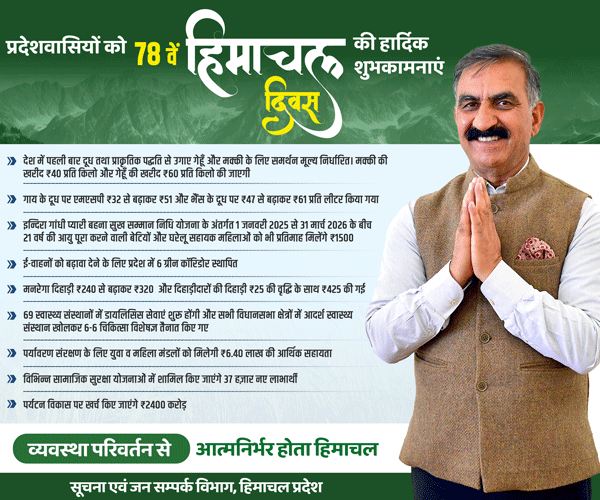The BJP which protested against paid yellow line parking concept proposed to be introduced during the left led MC in 2014, is today being seen advocating in favor of it. Then the local MLA and now Education minister of the state Suresh Bhardwaj had stated that the Shimla MC and state government were levying unnecessary charges on people of the city for their own shortcomings. He had stated that it was the failure of the local MC and state government, who could not create enough parking for citizens.
However after 5 years gone, it the BJP now reverting to same policy which they rejected 5 years back due to over swelled parking woes. In this period though a few new parking lots came up in the city but held no relevance for locals who wanted parkings closer to their residences/offices. Bigger parkings of the modern times were all created keeping tourist in mind.
Take Free HimachalScape Subscription Complete this form
Choose Your Membership
It is a well-known fact that the Shimla city is getting clogged with increasing number of private vehicles every year. As per 2018, statistics of the local administration more than 75000 nos vehicles are present in the city; out of which 65% are cars and remaining are two wheelers. Adding commuters from outside city, the number of vehicle in the city on daily basis is around 1.65lac (As per government data spelled in recent press communiqué). Whereas the total parking space available is barely around 9,000 eps. Clearly displaying a big demand and supply gap.
This problem of parking is acute in residential areas. Therefore, in many cases it is seen that people are parking their vehicles on the street thus even encroaching the right of way of pedestrians and public spaces. The recent ‘Jhajhedi’village accident was a cause of over growing parking on both sides of the road leading to the village. Reportedly due to tight road width this ill fated bus had to go on the ‘Kaccha’ portion on the side of the road, which suddenly collapsed, thus throwing the bus off road causing the accident claiming 3 lives.
After this incidence Chief Minister Jai Ram Thakur has announced strict measures to be taken in the matter, but the plan proposed is not close to a permanent solution it seems. Rather is more of bits and pieces of many previously proposed parking plans by successive governments/MCs.
Talk of the paid yellow line parking introduced. As per highways norms the road width at most places in Shimla city is less than prescribed. Point to ponder then is that creating yellow line paid parking not helps much. Firstly it would reduce the width of the current roads. Secondly in lack of service lanes (In and out of these parkings) would only attribute to become another reason for future traffic jams. Clearly the parking contactor (managing these yellow line parkings as per new policy of MC Shimla) would not to be able to manage traffic. Have a look at the current parking lots (Lift/Sanjauli/Victory tunnel), many traffic jams on daily basis are attributed to the lack of service lanes and weak traffic management skills of the parking contractor here. Perhaps the paid yellow line parkings can be a thought in the spur of the movement is all right, but is not a complete solution.
Experts say that it is a well established fact that road width of most part of the heritage city cannot be increased. Shimla has already over grown of its maximum capacity Therefore besides making parking available to citizens authorities should also focus on discouraging them from buying new vehicles. Simultaneously urgent measures should be taken to improve public transport system. “Moreover since Shimla is a small city, walking habits should be encouraged among locals and this can be done by creating small walking routes,” they added.
Giving example of other places in the world suffering the similar woes as Shimla, experts inform that places like Singapore, Hong Kong have similar issues, but they have tremendously improved their public transport systems, and side by side they are also discouraging citizens from buying new cars/vehicles.
To curb parking demand, experts proposed some measures. They state that concept of congestion pricing should be introduced around the Cart Road. The user fee should be high during morning (9.00AMto12.00noon) and evening (5.00PMto8.00PM) peak hours. Secondly they add that mandatory plying of staff /student buses through HRTC and private operators with more than 50 employees should be encouraged. Adding that penalty of Rs.1, 000/- per car per day should be levied for all cars parked outside these premises. Thirdly they state that Working Place Parking Levy (WPPL) to be introduced in public institutions at an initial stage and the same should be extended to private institutions/ organizations in the city. “Revenue generated from the WPPL may be used in improving public transport infrastructure,” they added. Fourthly a Certificate of entitlement (COE) should be introduced. COE is a license received in a successful winning bid in an open bid uniform price auction by MC Shimla recommending cases to the RTO/SDMs offices to grant the legal right of the holder to register own and use a vehicle within the city for a period of 10 years. “When demand is high, the cost of a COE should even exceed the value of the car itself,” they assert. Adding that the number of COE should be determined on a quarterly basis keeping in mind the holding capacity of the city. They further added that to minimize parking issues vehicles having crossed more than 15 years of life shall have to be abandoned. To minimize parking issues in residential areas and to reduce pressure on roads; road tax should be levied upto half the price of the 2nd car purchased by any house hold. “If the price of car is Rs. 10 lakh and above MC Shimla road tax upto 10% of the price of the car should be levied,” they add.
Construction of parkings in the city (Wardwise) might take some time. Meanwhile parking supply measures in residential areas should be applied, suggest experts. They state that community parking in each sector should be created by using neighborhood commercial and institutional parking lots overnight, on rental basis, to be managed and run by the registered Resident Welfare Associations (RWAs).
Though measures suggested by experts point towards an effective solution for the city problem, but implementation is a question mark. Wherein successive government have been batting in favour of illegal retention policies (Now stopped due to a NGT directive), then how is it feasible that they would be even think of a policy to levy such stringent norms on precious voters. Moreover such norms would invite protest from heavyweights which could hurt political aspirations. Therefore continually successive governments keep coming out with middle path solutions, which can hardly erase the overgrowing parking problems of the erstwhile summer capital.






